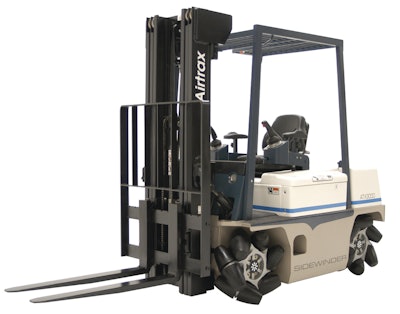
The Sidewinder fork truck, manufactured by Vehicle Technologies Inc. (Vetex), Trenton, NJ, utilizes uniquely designed wheels for omni-directional movement.
Around the circumference of each wheel are spindles canted at an angle, with each spindle containing a pair of rollers. Each wheel is independently controlled; the speed and direction with which each wheel moves determines the trajectory of the vehicle.
Two sets of opposing wheels, known as Type 1 and Type 2, are placed on opposite corners of the forklift. For example, the left front wheel and right back wheel would both be Type 1 wheels with rollers at a left-hand angle, while the right front wheel and left back wheel would both be Type 2 wheels containing rollers angled to the right.
Having the rollers on the Type 1 wheels positioned at an angle opposite that of the Type 2 wheels creates a right angle of force that keeps the vehicle balanced. This is also what enables the forklift to move in a variety of directions. “Any combination of [force] velocities will result in the vehicle moving in any direction in the plane,” says Nicholas Fenelli, President of Vetex.
When all four wheels rotate in the same direction, the Sidewinder will move forward or backward. Once the Type 1 wheels begin rotating in the opposite direction of the Type 2 wheels, however, the forklift will move sideways because of the force created by the opposing wheel movements. It also rotates a full 360 degrees when both wheels on the right side are directed to move in the opposite direction of the wheels on the left side.
Overcoming obstacles
The Sidewinder’s unique wheel design enables it to climb over obstacles that are about 1/4 of the wheel diameter. Since the rollers on each of the wheels are angled, the tips of the rollers are able to approach objects at an angle and engage like a tooth in a gear, lifting the entire wheel up and over obstacles.
Fenelli notes that while the Sidewinder is best suited for operation on a smooth, flat floor, testing has shown it can maneuver across a variety of environments. “We’ve actually taken the Sidewinder and driven it through grass, up on rocks, up steps,” says Fenelli. He says what limits the vehicle’s operation in outdoor environments is the work surface’s ability to support the weight of the Sidewinder. “If it sinks, it just loses its capability,” says Fenelli. When the Sidewinder sinks 3 to 4 inches deep into mud it begins twisting and losing its sideways movement capabilities.
The Sidewinder’s omni-directional technology has also been shown to perform well on slick surfaces, such as ice and the floors of engine test cells.
Electronics provide accuracy
Accurately controlling the speed and direction of each wheel independently is an important aspect to the omni-directional system’s functionality. According to Fenelli, electronic controls offer more accuracy and repeatability. “The flexibility of the programming and sophistication of the algorithms that we were able to obtain electronically was far superior to that of a straight hydraulic control,” says Fenelli.
Movement is determined by the Sidewinder’s joystick transmitting commands to the four wheels through a CAN bus. Each wheel has a controller that tells it how fast and in what direction to move based on the received CAN bus signal.
The vehicle will move in whichever direction the joystick is moved; pushing the joystick forward causes the forklift to go forward, while twisting the joystick counterclockwise will make the vehicle twist counterclockwise, and so on. Speed is determined by how far the joystick is pushed. “Choose a direction and choose a displacement,” says Fenelli, “and you’ve chosen the speed and direction the vehicle moves. The processor handles the rest.”
Fenelli says this system also makes the vehicle operator friendly. “It’s intuitive and there’s no slope to the learning curve,” he says. “In three minutes you know how to operate it and in half an hour you’re proficient.”
Electronics help with the efficiency and safety of the vehicle as well. According to Fenelli, when the Sidewinder was originally developed in the mid-90s it was the first AC powered electric vehicle in the United States. Regenerative braking recharges the battery as well as sustains the lifespan of the brakes. Stopping the vehicle electrically keeps the brakes from wearing out because they are never applied while the vehicle is moving.
Once the Sidewinder senses it has come to a stop and stayed motionless for a short period of time, the processor’s algorithms are able to tell there is no intention by the operator to move the forklift again anytime soon and automatically applies the safety brake. The system eliminates the need to worry about an operator getting off of the forklift and forgetting to set the parking brake.
Implementation on other vehicles
While Vetex continues to build and service the Sidewinder, the company’s main focus is developing and manufacturing robotic mobility platforms and custom built omni-directional vehicles. “There are all kinds of projects that people absolutely need these capabilities,” says Fenelli. “There’s no other way to solve their problem. And we help them with that.”
Fenelli says there’s really no limit to what type of vehicle the omni-directional system can be used on. The only obstacle is the weight of the vehicle.
“Our standard robotic platform has a capacity of 20,000 pounds on four wheels,” says Fenelli. Due to the system's modularity, however, more wheels can be added as needed. Fenelli says the company has created vehicles with anywhere from four wheels to 16, and has even created concepts for vehicles with 32 wheels.
“We’re in the business to solve material handling problems,” says Fenelli. “It’s no job too small.”




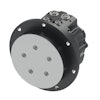
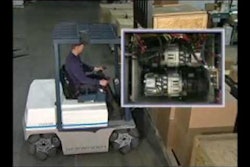
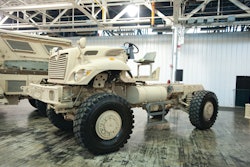
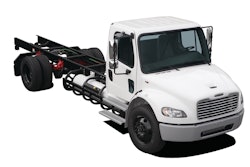









![Sa P75 I Sahr[80]](https://img.oemoffhighway.com/mindful/acbm/workspaces/default/uploads/2025/10/sa-p75-isahr80.Cn3n79HB4H.jpg?ar=16%3A9&auto=format%2Ccompress&fit=crop&h=135&q=70&w=240)

